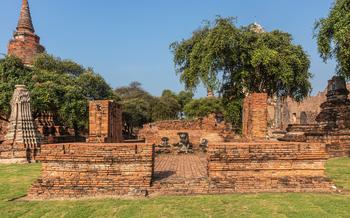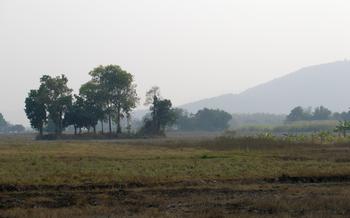
Sakaerat Environmental Research Station
- Sakaerat Environmental Research Station: A Pristine Haven for Nature Enthusiasts
- Location and Accessibility
- Admission and Fees
- Best Time to Visit
- Accommodation Options Nearby
- Guided Tours and Activities
- Highlights of the Sakaerat Environmental Research Station
- Hiking Trails and Trekking Routes
- Wildlife Spotting and Birdwatching
- Camping and Overnight Stays
- Research and Conservation Initiatives
- Photography and Videography
- Responsible Tourism Practices
- Local Cuisine and Dining Options
- Insider Tip: Secluded Spots and Hidden Gems
Sakaerat Environmental Research Station: A Pristine Haven for Nature Enthusiasts
Sakaerat Environmental Research Station: A Pristine Haven for Nature Enthusiasts Nestled in the heart of Northeast Thailand, the Sakaerat Environmental Research Station stands as a testament to the harmonious coexistence between scientific research and pristine natural beauty. Established in 1959, this 240-square-kilometer research station has become a sanctuary for nature enthusiasts, scientists, and researchers alike. Its unique ecosystems, diverse biodiversity, and dedication to conservation make it a must-visit destination for anyone seeking an immersive experience in nature's embrace.
A Commitment to Conservation and Research Sakaerat Environmental Research Station is a pioneer in conservation efforts in Thailand. Its mission is two-fold: to preserve the region's rich biodiversity and to promote sustainable development. The station's vast expanse of protected forest serves as a haven for numerous endangered species, including gibbons, hornbills, and elephants, while its ongoing research projects contribute to a deeper understanding of tropical forest ecosystems.
A Realm of Biodiversity The station encompasses a diverse array of habitats, from towering dipterocarp forests to lush bamboo groves and open grasslands. Within this realm of biodiversity, researchers have documented over 1,000 species of plants, 300 species of birds, and 50 species of mammals. The Sakaerat Forest is particularly renowned for its diverse birdlife, making it a paradise for birdwatchers and ornithologists.
Location and Accessibility
The Sakaerat Environmental Research Station is situated in the northeastern province of Nakhon Ratchasima, Thailand. It is approximately 180 kilometers from the provincial capital city of Nakhon Ratchasima and can be reached by car or public transportation. To get there by car, take Highway 2 (Mittrapap Road) northeast from Nakhon Ratchasima towards Pak Chong. After about 100 kilometers, turn left onto Highway 2094 and follow it for approximately 20 kilometers. The research station will be on your right.
If you prefer to use public transportation, take a bus from Nakhon Ratchasima to Pak Chong. From Pak Chong, catch a local bus or songthaew (shared taxi) to Sakaerat village. From the village, it is a short walk or motorbike ride to the research station.
Admission and Fees
Visiting the Sakaerat Environmental Research Station is a budget-friendly experience, with minimal fees to support its conservation efforts. Entrance fees are typically around 200 baht for adults and 100 baht for children. These fees directly contribute to the upkeep of the station's facilities and ongoing research initiatives.
The research station operates from 8:00 AM to 4:00 PM daily, allowing visitors ample time to explore the natural wonders within. It remains open throughout the year, except for occasional closures during specific holidays or maintenance periods.
Advance booking or reservations are not required, as the station welcomes visitors on a first-come, first-served basis. However, for larger groups or guided tours, prior arrangements can be made by contacting the research station directly.
Best Time to Visit
The Sakaerat Environmental Research Station welcomes visitors throughout the year, offering unique experiences in each season. The dry season, typically from November to April, presents the most favorable conditions for exploring the station. During this period, the weather is generally dry and sunny, with moderate temperatures, making it ideal for hiking, wildlife spotting, and birdwatching. The dry season also coincides with the peak blooming period of many plant species, showcasing the station's vibrant floral diversity.
While the rainy season, from May to October, brings lush greenery and abundant rainfall, it can also pose challenges for outdoor activities. Trails may become muddy and slippery, and some areas may be temporarily inaccessible due to flooding. However, the rainy season offers its own rewards, as the forest comes alive with the sounds of cascading waterfalls and the vibrant colors of blooming wildflowers. Birdwatching enthusiasts may also find this season particularly rewarding, as many migratory species visit the station during this time.
Regardless of the season, visitors should come prepared for tropical weather and pack appropriate clothing and footwear. It's advisable to check the weather forecast before your visit and be prepared for sudden changes in conditions, especially during the rainy season.
Accommodation Options Nearby
When planning a visit to the Sakaerat Environmental Research Station, finding suitable accommodation nearby is essential for a comfortable and enjoyable experience. Several options are available to cater to different budgets and preferences.
Within a short distance from the research station, visitors can find a range of hotels and guesthouses that offer a variety of amenities and facilities. These accommodations provide a convenient base for exploring the station's natural wonders while ensuring a comfortable stay.
For those seeking a budget-friendly option, there are several guesthouses that offer basic but clean and comfortable rooms. These guesthouses often provide shared facilities such as bathrooms and kitchens, allowing travelers to save on accommodation costs.
For a more luxurious experience, visitors can opt for hotels that offer private rooms with en-suite bathrooms, air conditioning, and other modern amenities. These hotels may also have facilities such as swimming pools, restaurants, and bars, providing a more comfortable and convenient stay.
To find the best accommodation options, it is advisable to book in advance, especially during peak seasons. Online booking platforms can be a convenient way to compare prices, read reviews, and secure reservations.
Additionally, visitors can explore unique lodging options such as treehouses, bungalows, or homestays in nearby villages. These options offer a more immersive experience, allowing guests to connect with the local culture and enjoy the tranquility of the natural surroundings.
Guided Tours and Activities
The Sakaerat Environmental Research Station offers guided tours that provide an enriching experience for visitors. These tours are led by knowledgeable guides who share insights into the station's unique ecosystems, biodiversity, and conservation efforts. Visitors can choose from various tours tailored to their interests, such as birdwatching, wildlife spotting, or trekking.
Guided tours typically last for several hours and cover different areas of the research station. During these tours, visitors can expect to encounter a variety of wildlife, including gibbons, hornbills, elephants, and numerous bird species. Guides also provide information about the station's ongoing research projects and conservation efforts, making the tour not only enjoyable but also educational.
For those who prefer a more independent exploration, self-guided trails are available. These trails are well-marked and offer visitors the freedom to explore the forest at their own pace. Visitors can choose from various trails ranging in difficulty from easy to challenging, allowing them to tailor their experience to their fitness level and interests.
Highlights of the Sakaerat Environmental Research Station
The Sakaerat Environmental Research Station abounds with natural wonders and captivating attractions that will enthrall nature enthusiasts. Among its key highlights is the Wang Takhian Waterfall, a cascading marvel nestled amidst lush greenery. The Pha Kluai Mai Viewpoint offers panoramic vistas of the surrounding landscape, stretching as far as the eye can see. The Huai Yai Reservoir mesmerizes with its tranquil waters, providing a serene haven for wildlife.
The station boasts a remarkable diversity of flora, with over 1,500 plant species identified. Keep an eye out for the giant rain trees, towering specimens that command attention with their impressive stature. The Venus flytrap, a carnivorous plant, adds an element of intrigue to the botanical wonders of Sakaerat.
In terms of fauna, Sakaerat is home to a rich array of animal species, including gibbons, hornbills, and elephants. Birdwatching enthusiasts will delight in the opportunity to spot over 300 species of birds, including the great hornbill, a majestic bird with a distinctive casque. The Sakaerat Huai Yai Gibbon Rehabilitation Center provides a glimpse into the conservation efforts undertaken at the station, offering visitors a chance to learn about the plight of these critically endangered primates.
Whether you're drawn to the cascading allure of waterfalls, panoramic vistas, tranquil reservoirs, diverse flora, or vibrant wildlife, the Sakaerat Environmental Research Station promises an unforgettable experience for every nature lover.
Hiking Trails and Trekking Routes
The Sakaerat Environmental Research Station offers a network of well-maintained hiking trails, catering to hikers of varying skill levels. These trails wind through the diverse ecosystems of the forest, providing opportunities for exploration, wildlife spotting, and immersion in the natural beauty of the area.
Beginner Trails: - Nature Trail: A gentle and accessible trail perfect for families and casual hikers. It leads through a mixed deciduous forest, showcasing a variety of plant and animal life. - Bamboo Trail: This trail takes hikers through a dense bamboo forest, offering a unique and serene experience. It is ideal for those seeking a peaceful and shaded walk.
Intermediate Trails: - Waterfall Trail: This trail leads to a picturesque waterfall, cascading down into a refreshing pool. It offers moderate elevation gain and stunning views of the surrounding forest. - Hilltop Trail: This trail leads to the highest point within the research station, providing panoramic views of the Sakaerat Forest and the surrounding countryside.
Advanced Trails: - Gibbon Trail: This challenging trail takes hikers through the Gibbon Rehabilitation Project area, where they may encounter these fascinating primates in their natural habitat. - Hornbill Trail: This trail offers a chance to spot hornbills and other rare bird species, as it winds through a section of the forest known for its rich birdlife.
Each trail is well-marked with clear signage, ensuring that hikers can navigate safely and independently. The research station also provides trail maps and guides to enhance the hiking experience. Visitors are advised to wear comfortable shoes, bring adequate water, and consider using insect repellent during their trek.
Wildlife Spotting and Birdwatching
The Sakaerat Environmental Research Station is a haven for birdwatchers and wildlife enthusiasts, with over 300 species of birds recorded within the forest. The diverse habitats, from evergreen forests to wetlands, support a rich array of avian life. Visitors can spot hornbills, barbets, woodpeckers, and a variety of migratory birds during different seasons.
Early mornings and late afternoons are the best times for birdwatching, when the birds are most active. Birders should bring binoculars or a spotting scope to enhance their viewing experience. The station's staff and experienced guides can provide valuable information and lead birdwatching tours for visitors.
In addition to birds, the Sakaerat Forest is home to a variety of mammals, reptiles, and amphibians. Visitors may encounter gibbons, macaques, wild boar, barking deer, and even elephants in the deeper parts of the forest. Keep your eyes peeled for snakes, lizards, and frogs, which play an important role in the ecosystem.
Remember to maintain a respectful distance from wildlife and avoid disturbing their natural behavior. Photography is allowed, but using flash photography near animals is discouraged. By following responsible wildlife viewing practices, visitors can contribute to the conservation of this unique and fragile ecosystem.
Camping and Overnight Stays
For those seeking an immersive experience in the heart of the Sakaerat Environmental Research Station, camping is a fantastic option. Designated camping areas are available within the station, allowing visitors to spend the night under the stars and wake up to the sounds of the rainforest. Basic facilities such as restrooms and showers are provided, ensuring a comfortable stay. Remember to bring your own camping gear, including tents, sleeping bags, and cooking equipment. Campfires are not permitted to minimize the risk of forest fires. Instead, portable stoves or gas burners are recommended for cooking. Embrace the serenity of the rainforest as you fall asleep to the gentle chirping of crickets and the distant calls of nocturnal animals. Waking up to the chorus of birdsong and the fresh, invigorating air of the rainforest is an experience that will stay with you long after your visit.
Research and Conservation Initiatives
The Sakaerat Environmental Research Station serves as a vital hub for scientific research and conservation efforts, contributing significantly to our understanding of tropical rainforest ecosystems. Researchers from various disciplines, including ecology, botany, and zoology, conduct long-term studies on the station's diverse flora and fauna. These studies provide valuable insights into the intricate relationships between species and their habitats, helping us better understand the functioning of tropical rainforests.
Additionally, the station plays a crucial role in conserving the region's rich biodiversity. It collaborates with local communities and conservation organizations to implement various conservation initiatives, such as reforestation programs, habitat restoration projects, and wildlife monitoring. These efforts aim to protect endangered species, maintain ecological balance, and ensure the long-term sustainability of the rainforest ecosystem.
Visitors to the Sakaerat Environmental Research Station have the unique opportunity to contribute to these ongoing research and conservation efforts. Guided tours often incorporate educational components, allowing visitors to learn about the station's research projects and the importance of rainforest conservation. Some tours even offer hands-on experiences, such as birdwatching surveys or wildlife tracking, enabling visitors to actively participate in the research process.
By visiting the Sakaerat Environmental Research Station, you not only immerse yourself in the wonders of the rainforest but also contribute to the preservation of this critical ecosystem. Your presence supports the tireless work of researchers and conservationists who are dedicated to protecting and understanding one of the world's most valuable natural treasures.
Photography and Videography
The Sakaerat Environmental Research Station is a visual paradise for photographers and videographers, offering endless opportunities to capture stunning shots of nature's wonders. The diverse landscapes, unique flora, and abundant wildlife present a kaleidoscope of colors, textures, and movements.
To fully immerse yourself in this visual feast, come equipped with a high-quality camera and a variety of lenses. A telephoto lens will allow you to zoom in on distant wildlife and capture close-up details, while a wide-angle lens will help you capture the vastness of the forest and sweeping landscapes.
As you explore the station, keep an eye out for the vibrant colors of the butterflies and birds that flit through the trees. The shimmering waters of the streams and waterfalls provide beautiful reflections and create a sense of tranquility. The towering trees, with their intricate root systems and lush canopies, offer endless opportunities for creative compositions.
While capturing the beauty of the station, remember to be respectful of the wildlife and their habitats. Avoid using flash photography, which can disturb animals, and always maintain a safe distance. Adhere to the regulations regarding photography and videography within the station to ensure that your actions do not negatively impact the environment or its inhabitants.
Whether you're a seasoned photographer or an amateur enthusiast, the Sakaerat Environmental Research Station promises a rich and rewarding experience. So come prepared to capture the essence of this natural wonderland and share your stunning creations with the world.
Responsible Tourism Practices
As you embark on your journey through the Sakaerat Environmental Research Station, it is essential to embrace responsible tourism practices that minimize your impact on this delicate ecosystem. Tread lightly and leave no trace. Dispose of waste properly, respecting the natural beauty of the surroundings. Avoid disturbing wildlife habitats by maintaining a respectful distance and refraining from loud noises. Support local communities and businesses that actively promote sustainable tourism, ensuring the long-term conservation of this unique natural treasure. Remember, the preservation of this pristine haven relies on our collective actions. Let us all be mindful travelers, leaving behind only footprints and taking away unforgettable memories.
Local Cuisine and Dining Options
For a taste of authentic Thai cuisine, head to the nearby town of Pak Thong Chai, where you can savor delicious local dishes. Sample the spicy papaya salad (som tum), the flavorful grilled chicken (gai yang), or the aromatic noodle soup (kuay tiew). For a unique dining experience, try the floating market in Korat, where vendors sell their wares from boats on the canal. Don't miss the opportunity to indulge in fresh tropical fruits, such as mangoes, pineapples, and rambutans, which are in abundance in this region. When in doubt, ask the locals for their recommendations and be prepared to be delighted by the culinary treasures of Nakhon Ratchasima.
Insider Tip: Secluded Spots and Hidden Gems
For those seeking solitude and tranquility, the Sakaerat Environmental Research Station offers a myriad of hidden gems and secluded spots to escape the crowds and immerse oneself in the embrace of nature. Venture off the main trails and discover a serene waterfall tucked away in the lush forest, where the sound of cascading water creates a symphony of peace. Follow the winding paths to find a secluded clearing, ideal for a picnic or a moment of meditation amidst the tranquil surroundings. As the sun dips below the horizon, find a secluded viewpoint to witness the sky ablaze with vibrant colors, a breathtaking spectacle that paints the canvas of nature with hues of orange, purple, and pink. With a little exploration and a sense of adventure, uncover the hidden treasures that lie within the Sakaerat Environmental Research Station, creating memories that will last a lifetime.







